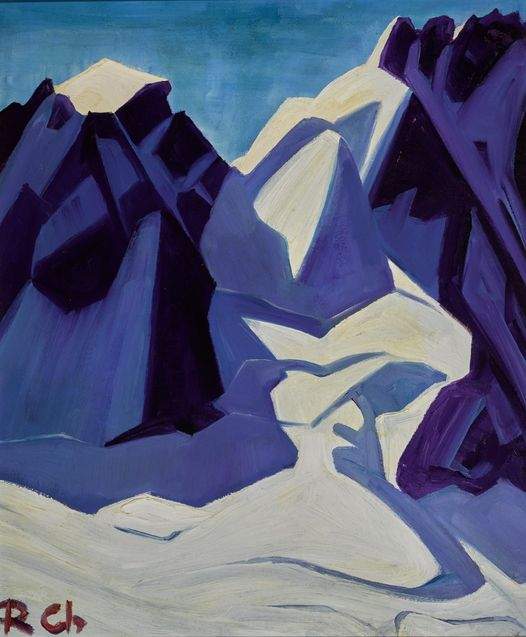Thirty years after his death, the Fortress of Bard is dedicating a monographic exhibition(The Titanic Mountain of Renato Chabod, through Jan. 10, 2021) to Renato Chabod (Aosta, 1909 - Ivrea, 1990), a representative figure in the political, cultural and mountaineering life of Valle d’Aosta and the nation. The only Senator from Valle d’Aosta to rise to the position of Vice-President of the Senate, Chabod was for many years President General of the CAI, to which we owe the current legal structure of Public Body and Italian Academic Alpine Club. Renato Chabod’s pictorial work developed in parallel with his life as a politician and mountaineer, to which it is closely connected. Through the study and presentation of about sixty paintings, alpine diaries and freehand sketches, the exhibition aims to build an interpretive, but also human and intellectual, link between his works, his public and private life and his civil commitment.
The key to the interpretation of Chabod’s painting lies precisely in his being a mountaineer: the mountains he paints are those known through the sensory experience of climbing, in a silent dialogue with the summit to be tackled that excludes any other living being. The exhibition takes this close relationship into account by presenting in parallel the plates and drawings that preceded them, to trace the mountaineering itineraries he traveled.
Under the patronage of the Italian Alpine Club, the National College of Italian Mountain Guides, Unione Valdostana Guide Alta Montagna / Regional College of High Mountain Guides and the Museum of the Mountain - Cai Torino.
Renato Michele Giuseppe Chabod was born in Aosta, Italy, on July 28, 1909. The last of three brothers, he was orphaned at the age of nine because his father died during the Spanish flu epidemic. He managed to complete his studies, like his brothers, thanks to the income from the Chabod Legate established by one of his ancestors in 1803. His two maternal uncles were both career officers in the Alpini and participated in the Great War. Renato began his mountaineering activities when he was only 13 years old with his peer Amilcare Crétier first climbing the Roman walls of Aosta, the various rock gyms in the area finally the Gran Paradiso, the Forquin, and the Clocher of Djouan. In 1927, after a frostbite suffered during a long ski traverse, his big toe was amputated. From success to success, between 1929 and 1935, he was the most important mountaineer in Valle d’Aosta at the time with numerous first ascents in the Paradiso and Bianco groups. In 1934 he participated with Bonacossa, Binaghi, Boccalatte, Brunner, Paolo and Stefano Ceresa, Gervasutti, Ghiglione and Zanetti in an expedition to the Andes.
AfterAconcagua, he made the first ascent of Cerro Cuerno. Although his mountains occupied him intensely, he was always a brilliant student; he finished Liceo Classico at D’Azeglio in Turin and graduated in law. An academic mountaineer since 1930, after serving as president of the Mountain Guides of Courmayeur from 1934 to 1942, he was president of the National Consortium of Guides and Bearers of the CAI from 1956 to 1965, general president of the CAI from 1965 to 1971, and finally president of the CAI (Italian Academic Alpine Club) from 1975 to 1979. As a mountaineer-painter he wrote and illustrated, with sketches and paintings, the manual Alpinismo (1935); the Cai guides of Gran Paradiso (eds. 1939, 1963, 1980) and Mont Blanc (in two volumes, 1963 and 1968); La Cima di Entrelor (1969), a history of his mountaineering activities; Camarade prend ton verre. History of the Courmayeur Guides (1972) and Montagnes Valdôtaines (1974), a succinct but comprehensive description of the peaks, refuges and passes of the Aosta Valley.
When the madness of the 1940 war hitEurope, his choices led him to the Resistance in the Valley along with his brother Federico and cousin Remo. He became a regional councilor in the 1950s, Mayor of Courmayeur from 1965 to 1967, Senator from 1958 to 1968, and in 1967 was elected Vice-President of the Senate. Chabod died in Ivrea in 1990.
The exhibition The Titanic Mountain of Renato Chabod is open until January 10, 2021.
For all information you can visit the official website of the Fortress of Bard.
 |
| Senate vice president, painter, mountaineer: an exhibition on the life of Renato Chabod |
Warning: the translation into English of the original Italian article was created using automatic tools. We undertake to review all articles, but we do not guarantee the total absence of inaccuracies in the translation due to the program. You can find the original by clicking on the ITA button. If you find any mistake,please contact us.